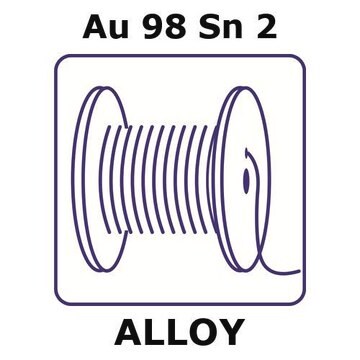GF44189242
Tin
wire reel, 1m, diameter 0.25mm, as drawn, 99.99+%
Synonyme(s) :
Tin, SN005110
Se connecterpour consulter vos tarifs contractuels et ceux de votre entreprise/organisme
About This Item
Formule empirique (notation de Hill):
Sn
Numéro CAS:
Poids moléculaire :
118.71
Numéro MDL:
Code UNSPSC :
12352300
ID de substance PubChem :
Nomenclature NACRES :
NA.23
Produits recommandés
Pureté
99.99%
Forme
wire
Fabricant/nom de marque
Goodfellow 441-892-42
Résistivité
11 μΩ-cm, 20°C
L × diam.
1 m × 0.25 mm
Point d'ébullition
2270 °C (lit.)
Pf
231.9 °C (lit.)
Densité
7.310 g/mL at 25 °C (lit.)
Chaîne SMILES
[Sn]
InChI
1S/Sn
Clé InChI
ATJFFYVFTNAWJD-UHFFFAOYSA-N
Catégories apparentées
Description générale
For updated SDS information please visit www.goodfellow.com.
Informations légales
Product of Goodfellow
Certificats d'analyse (COA)
Recherchez un Certificats d'analyse (COA) en saisissant le numéro de lot du produit. Les numéros de lot figurent sur l'étiquette du produit après les mots "Lot" ou "Batch".
Déjà en possession de ce produit ?
Retrouvez la documentation relative aux produits que vous avez récemment achetés dans la Bibliothèque de documents.
M R Krigman et al.
Neurotoxicology, 5(2), 129-139 (1984-01-01)
The toxicology of tin is almost entirely the toxicology of the organic compounds of tin, for the metal itself and its inorganic compounds appear to be nearly harmless for practical purposes. Furthermore, the neurotoxicity of organotin is essentially that of
Heinz Rüdel
Ecotoxicology and environmental safety, 56(1), 180-189 (2003-08-14)
This article reviews the literature related to the bioavailability of tin, inorganic tin compounds, and organotin compounds. On the one hand, the toxicity of metallic tin and inorganic tin compounds is low. In aqueous systems, the potential bioavailability of tin
Steve Blunden et al.
Food and chemical toxicology : an international journal published for the British Industrial Biological Research Association, 41(12), 1651-1662 (2003-10-18)
Tinplate is light gauge, steel sheet or strip, coated on both sides with commercially pure tin and has been used for well over a hundred years as a robust form of food packaging. Altogether, about 25,000 million food cans are
Commonly used methods of analysis for tin in foods.
W Horwitz
Journal - Association of Official Analytical Chemists, 62(6), 1251-1264 (1979-11-01)
P Mushak
Neurotoxicology, 5(2), 163-176 (1984-01-01)
Methods for both total and form-variable tin analysis in biological media are reviewed. While total tin analysis was common in the past, and in some cases still is, better understanding of the toxicology and toxicokinetics of organotins in biological systems
Notre équipe de scientifiques dispose d'une expérience dans tous les secteurs de la recherche, notamment en sciences de la vie, science des matériaux, synthèse chimique, chromatographie, analyse et dans de nombreux autres domaines..
Contacter notre Service technique





